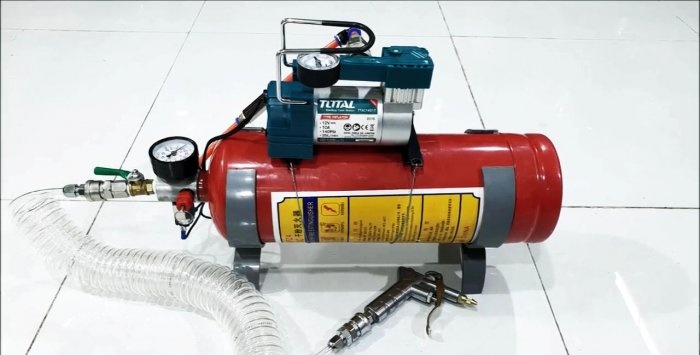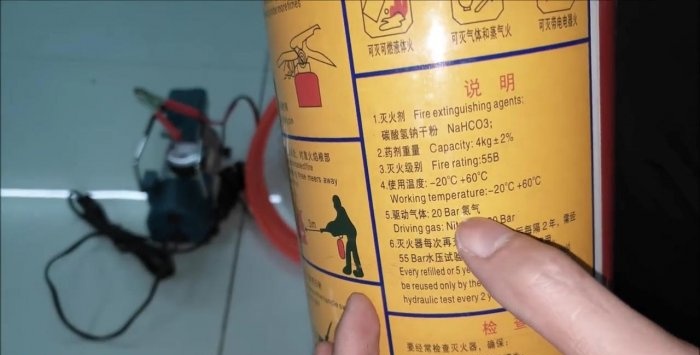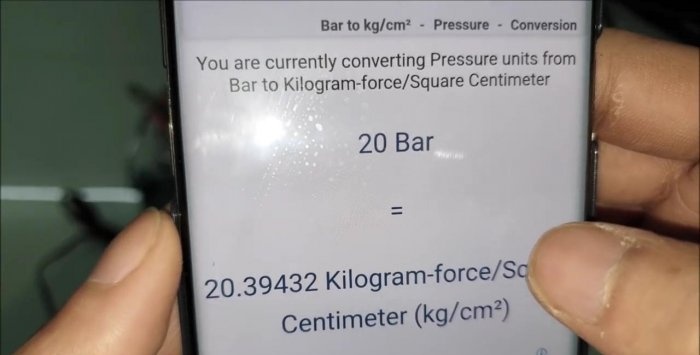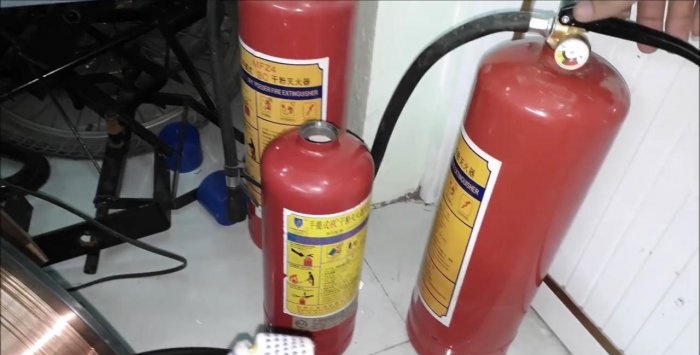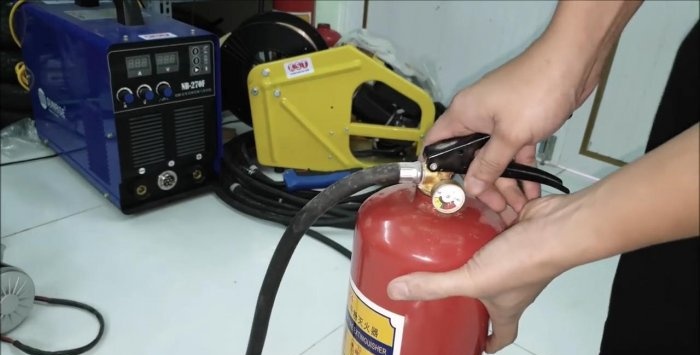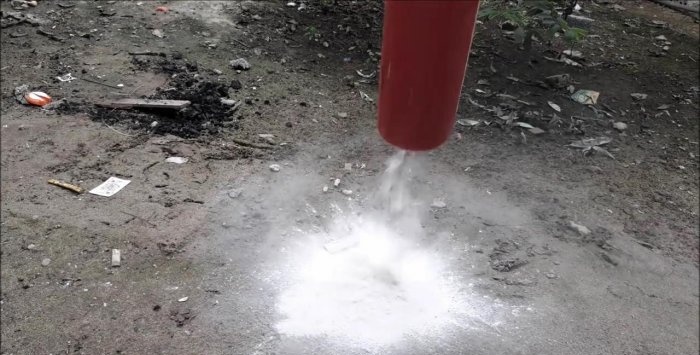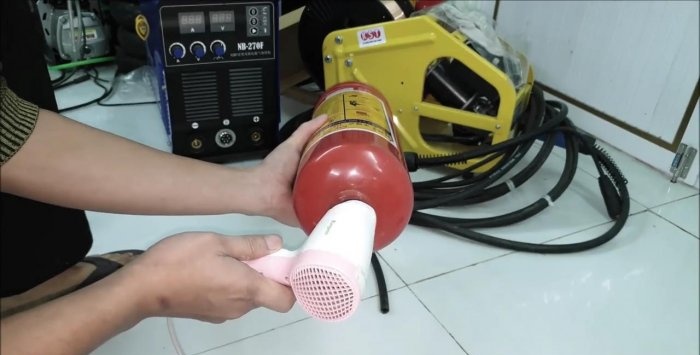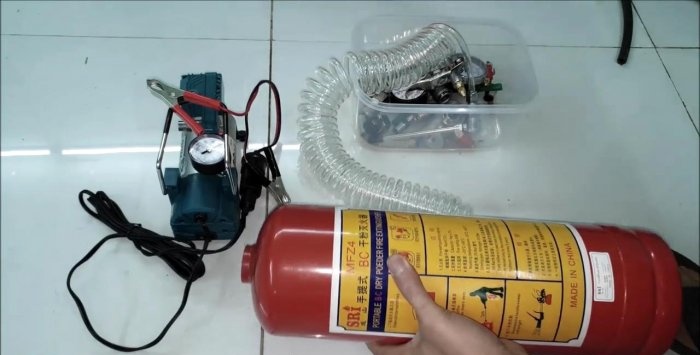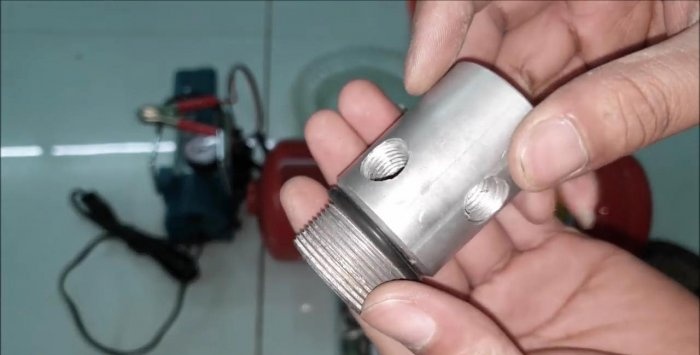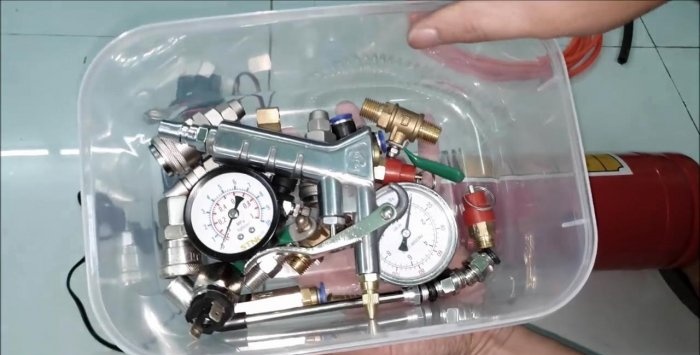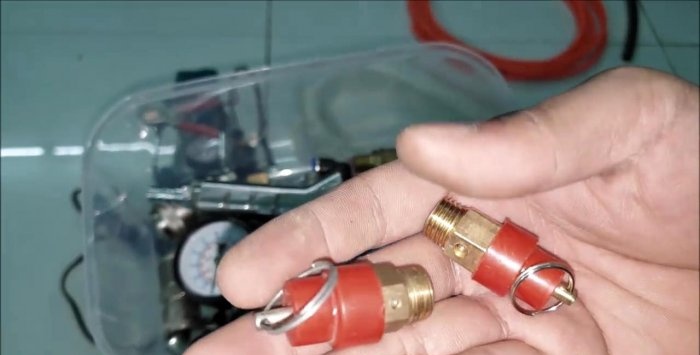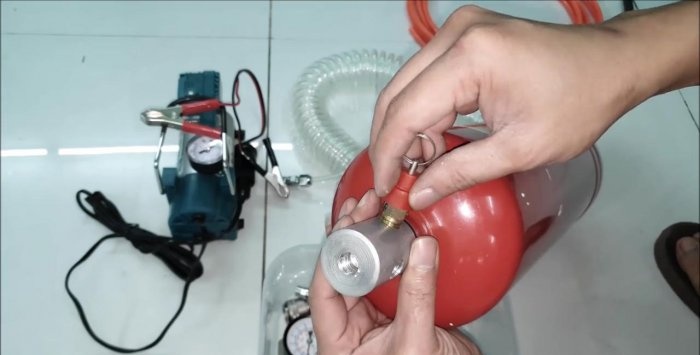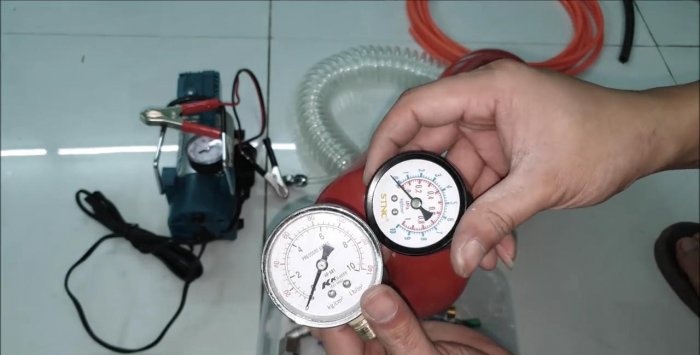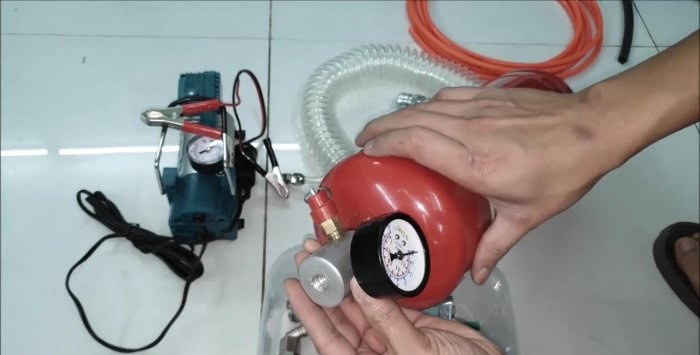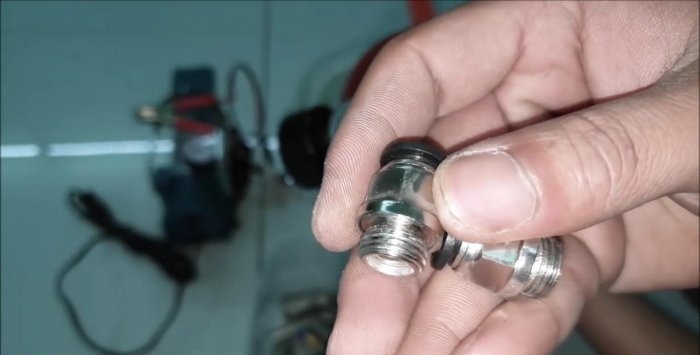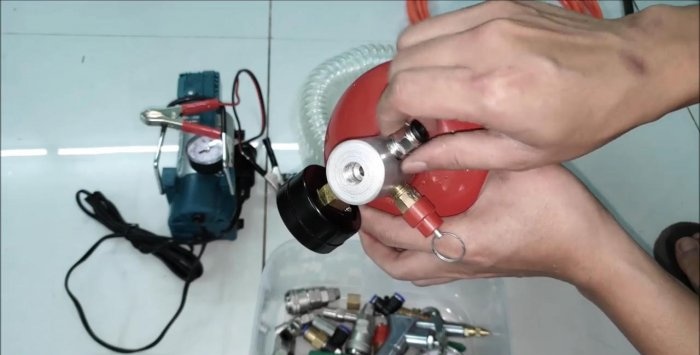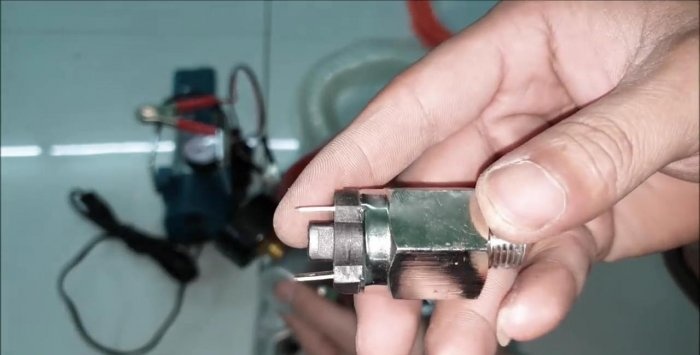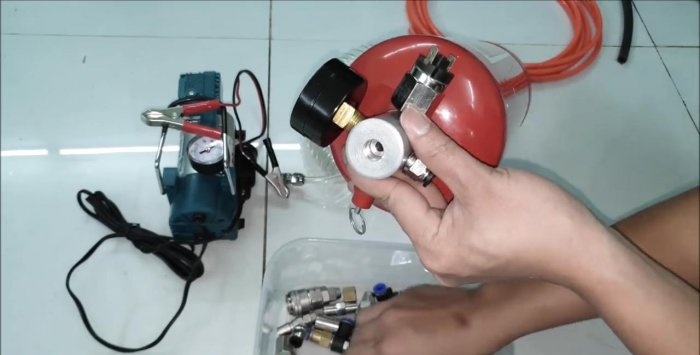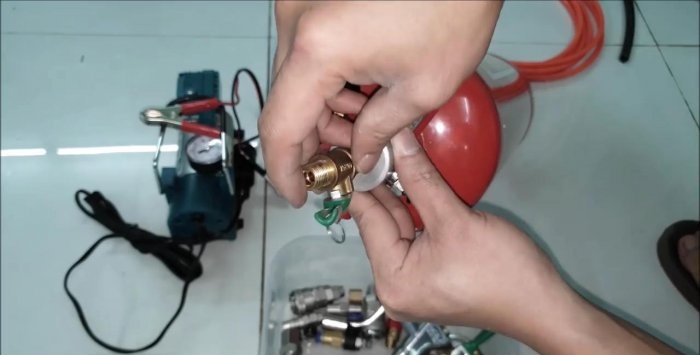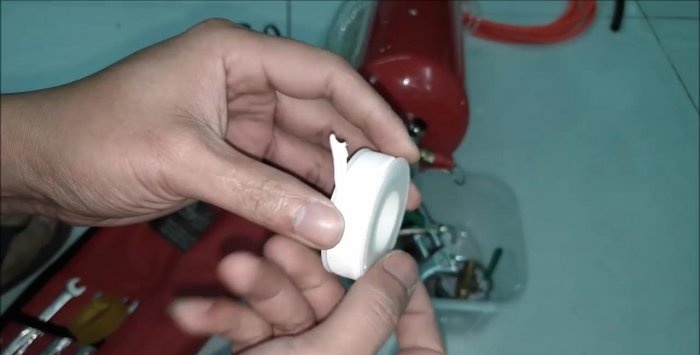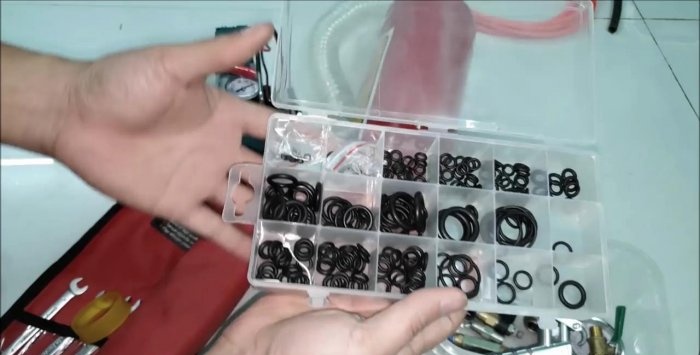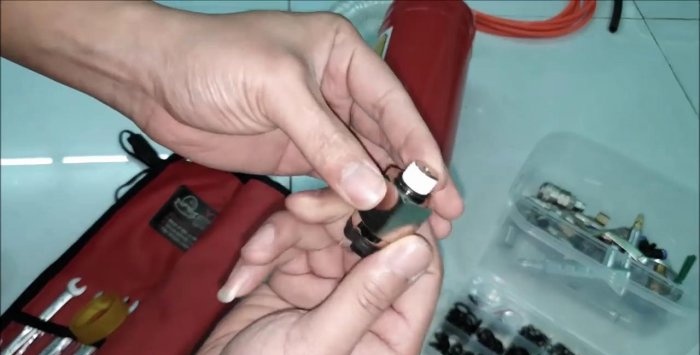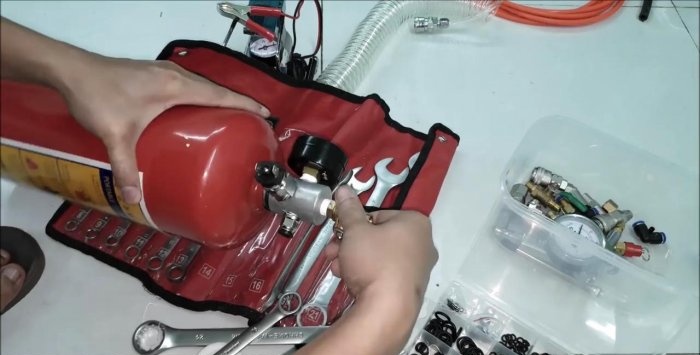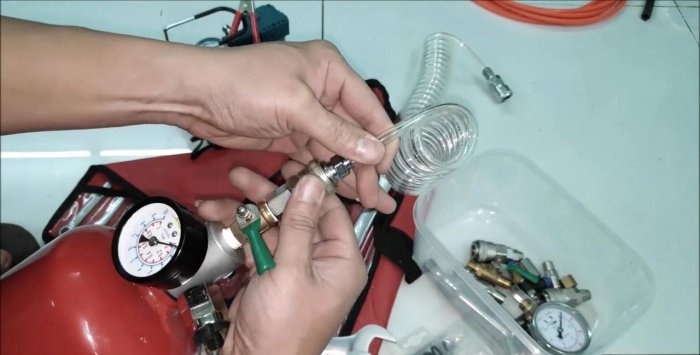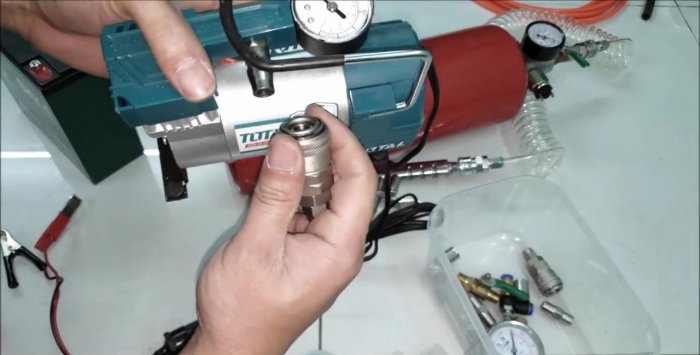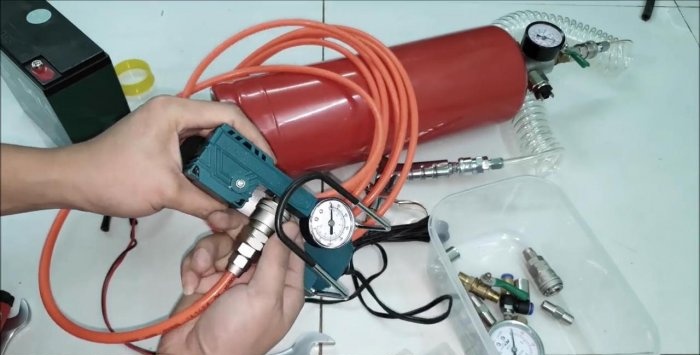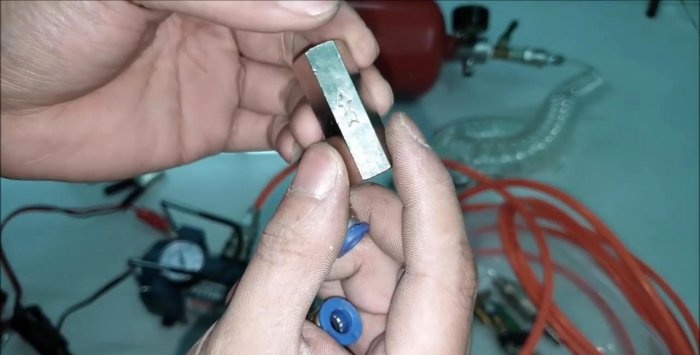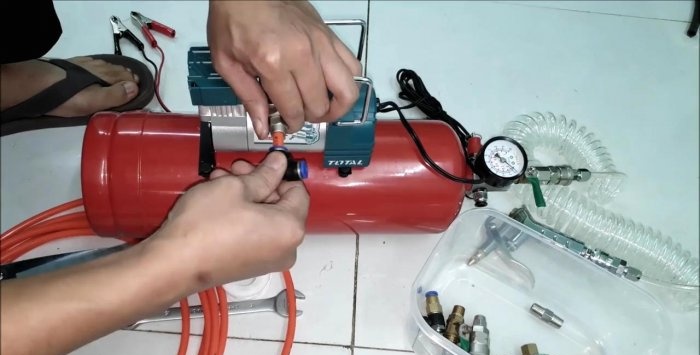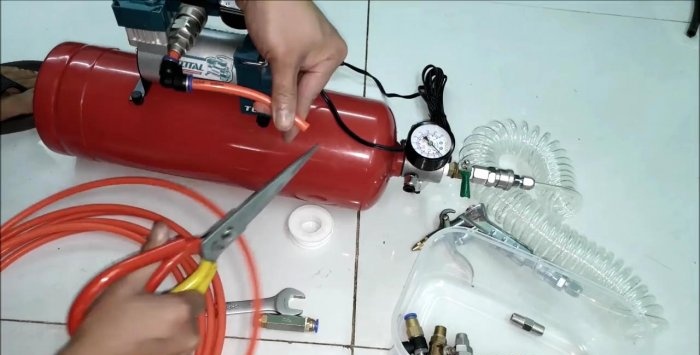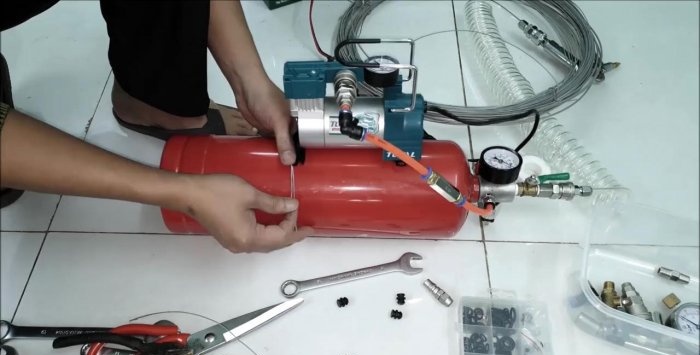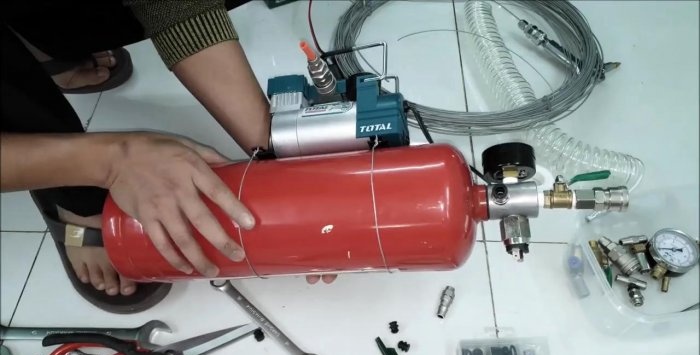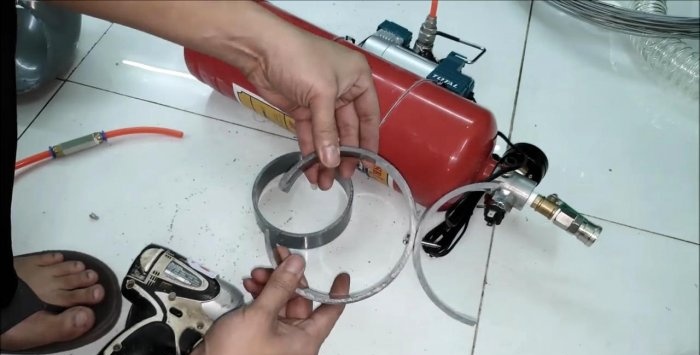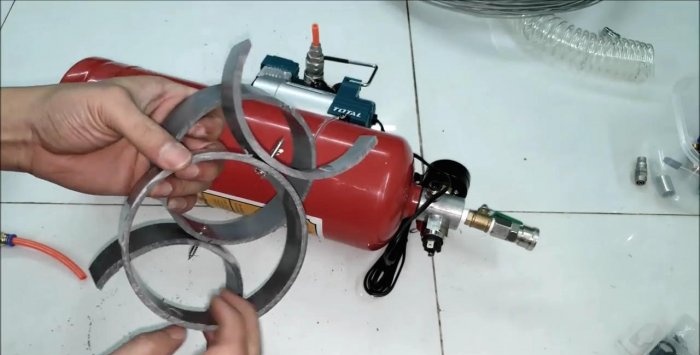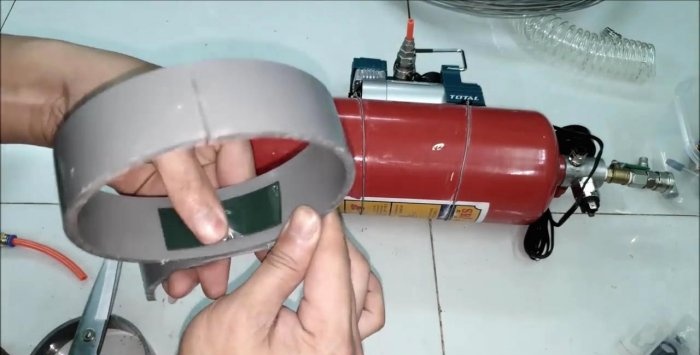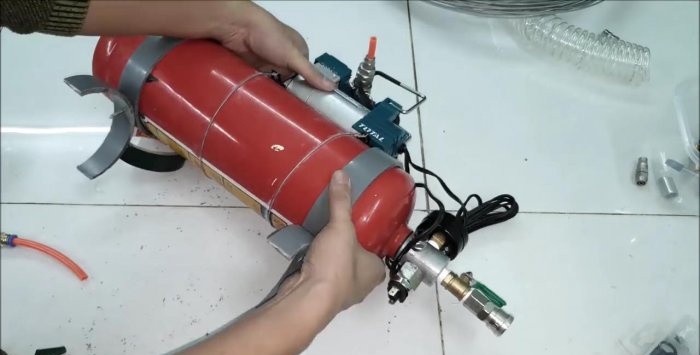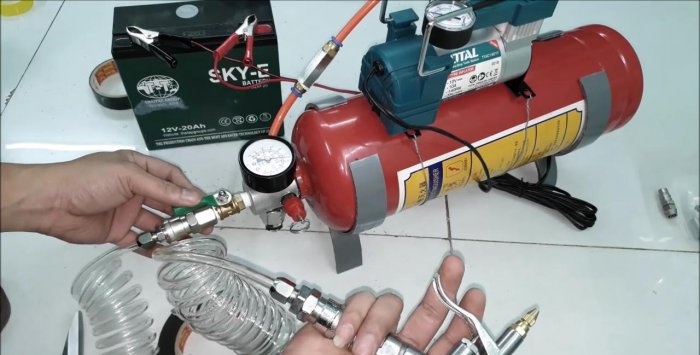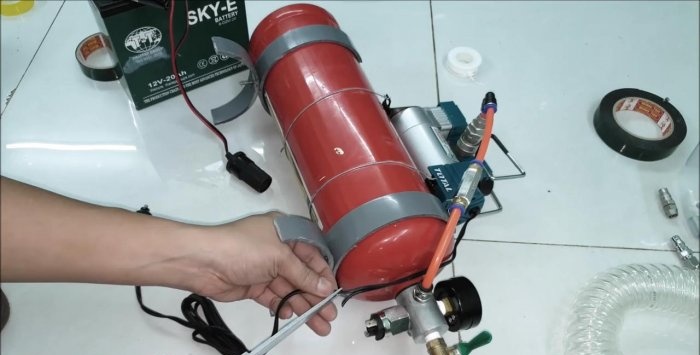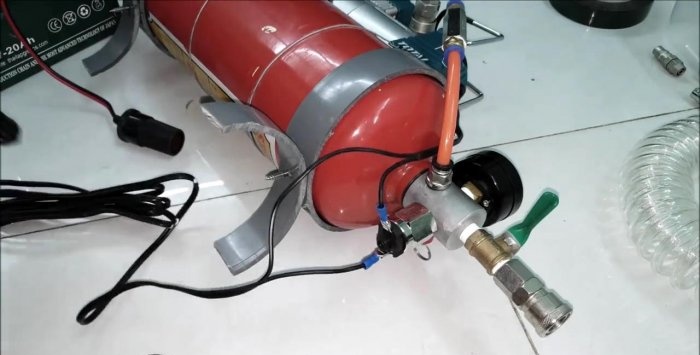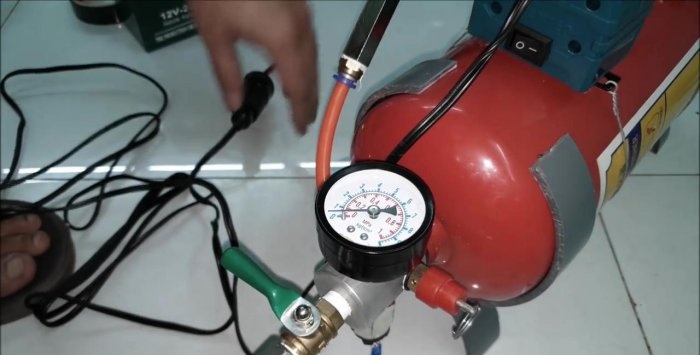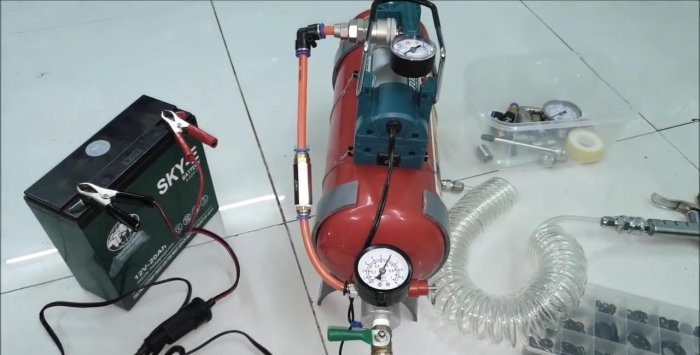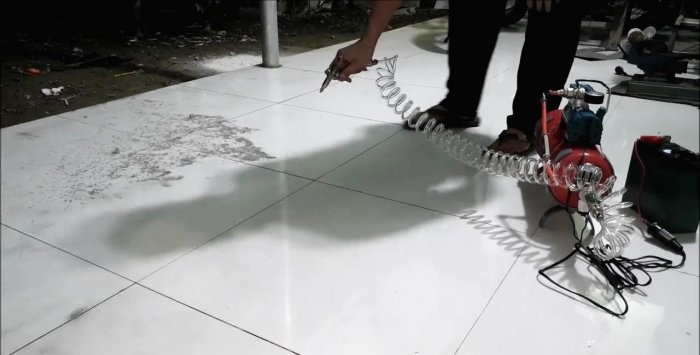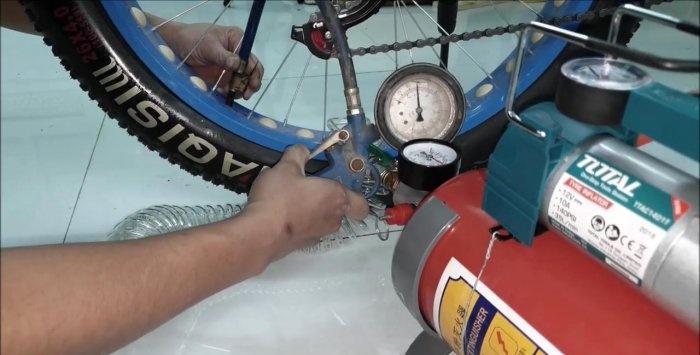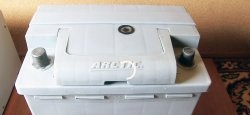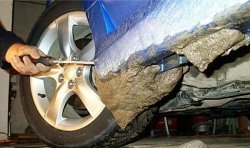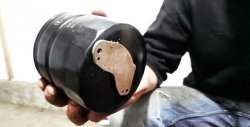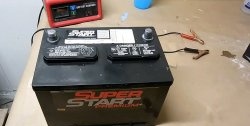How to make a receiver for a 12 V compressor from a fire extinguisher
Using a 12-volt compressor, you can pump up tires, remove debris and dust, blow out (clean) grill elements, inflate balls, supply compressed air to a spray gun, etc.
If the compressor is equipped with a receiver, its operating mode will be easier. After all, such a container creates a supply of compressed air, which allows you to take breaks in the operation of the compressor.
At the same time, the quality of the supplied air will increase, since the receiver equalizes the pressure, smoothes out pulsations, cools the compressed air coming from the compressor, and collects condensate.
Our installation will consist of two main parts: a compressor and a receiver - the fire extinguisher body. For safe and reliable operation of the device, it is important that the pressure created by the compressor (140 psi ≈ 10 bar ≈ 10 kg/sq.cm) does not exceed the pressure for which the fire extinguisher body is designed (20 bar ≈ 20 kg/sq.cm).
To create an installation that operates in automatic mode, we will need the following accessories:
To assemble individual units into a single whole, we will need:
It is better to choose a fire extinguisher with a large volume for the receiver. In this case, its efficiency when working in tandem with a compressor will be higher.
Next, we unscrew the shut-off valve with a hose, shake out its contents from the body (usually this is a substance based on ammonium phosphates, as it is the cheapest, but there may be other compositions).
Then we rinse the inside of the fire extinguisher body with clean water several times. Wipe the outside of the container with a clean cloth and dry the inside with a hair dryer.
Before this stage of work, we once again compare the characteristics of the compressor and the former fire extinguisher housing, and make sure that our receiver will meet the capabilities of the compressor in all respects.
We screw a locking assembly with a central channel and four threaded side holes into the neck of the metal container.
We screw a safety valve into one of the side channels, adjusting it to a lower opening pressure.
Of the two available pressure gauges, select the one that is calibrated in bar pressure units, and also screw it into the other side channel on the locking unit.
In the two remaining channels we screw in an adapter and a pressure switch - the main element of the automation system, which turns on the compressor when the pressure in the receiver becomes less than the operating one.
We screw a ball valve into the shut-off unit from above to supply compressed air from the receiver or its shut-off.
Next, using a set of rubber rings, FUM tape and keys, we seal and strengthen the joints of all elements with the locking unit and the latter with the body of the future receiver.
It remains to screw onto the ball valve, also using an O-ring and FUM tape, an adapter for installing a spiral hose, at the other end of which a tool powered by compressed air (we have a pneumatic gun) will be attached through the same adapter.
We first check its functionality by connecting it to a 12-volt battery and make sure that everything is in order with it.
We put a hose adapter on the compressor outlet fitting. We seal using FUM tape and firmly tighten the hex connector with keys.
We install the compressor on the receiver in the place where it will later be fixed. We cut off the hose at the outlet with scissors, leaving a small extension onto which we put a plastic rectangular fitting. It is necessary to give the desired direction to the hose that will come out of it and connect to the adapter on the receiver. Between the last two parts, a hexagonal connector is cut into the hose - it is also a check valve.
We glue strips of double-sided tape onto the supporting surfaces of the compressor base. This will allow you to pre-fix the nodes relative to each other, and further contribute to the strength of the connection.
Then, using pliers and a binding wire, which we pass through the holes in the base, firmly screw the compressor to the receiver.
To do this, you will need a piece of plastic pipe comparable in size to the outer diameter of the receiver. Using a hacksaw, cut three rings of equal width from the pipe.
We make a cross-section in two rings so that they can be put on the receiver. Cut the third ring into two equal parts. They, in fact, will be the “legs” of our installation.
In two rings, at points diametrically opposite to the cuts, we drill holes using a drill. We do the same in the half rings in their center.
We connect rings with half rings in pairs using screws and a drill, screwing in the hardware from the side of the split full ring.
On the inside of the split rings, covering the heads of the screws, we glue a strip of double-sided tape to fix the rings on the receiver body from below.
We install the rings on the receiver, spreading them along the cut. To firmly fix the rings on the surface of the receiver, we also glue a strip under each end of the ring, starting from the cut and below.
After connecting the hoses and turning on the compressor, we check the pressure build-up in the receiver using a pressure gauge and the operation of the installation using a pneumatic gun when the power is turned off. We release the pressure in the receiver using the safety valve by pulling the ring on the rod.
We cut one strand of the wire from the compressor and connect its ends to the pressure switch using lugs and a crimper. We turn on the compressor again and make sure that the pressure in the receiver increases.
Using a hexagon, we adjust the maximum pressure in the receiver, which we chose to be 7 bar. Now, while cleaning the surface from debris using a pneumatic gun, inflating bicycle tires, etc., the relay will maintain a pressure in the receiver equal to 7 bar by automatically turning the compressor on and off.
If the compressor is equipped with a receiver, its operating mode will be easier. After all, such a container creates a supply of compressed air, which allows you to take breaks in the operation of the compressor.
At the same time, the quality of the supplied air will increase, since the receiver equalizes the pressure, smoothes out pulsations, cools the compressed air coming from the compressor, and collects condensate.
Required accessories
Our installation will consist of two main parts: a compressor and a receiver - the fire extinguisher body. For safe and reliable operation of the device, it is important that the pressure created by the compressor (140 psi ≈ 10 bar ≈ 10 kg/sq.cm) does not exceed the pressure for which the fire extinguisher body is designed (20 bar ≈ 20 kg/sq.cm).
To create an installation that operates in automatic mode, we will need the following accessories:
- a shut-off unit on the receiver with a system of threaded channels;
- safety valve;
- pressure gauge with scale in bars;
- switch pressure switch;
- valve in the form of a ball valve;
- spiral and linear hoses;
- air gun;
- 12 Volt battery;
- fittings, unions and adapters.
To assemble individual units into a single whole, we will need:
- keys and pliers;
- drill and crimper (means for crimping wire lugs);
- hacksaw and scissors;
- O-rings and FUM tape;
- knitting wire and double-sided tape;
- piece of plastic pipe.
Making a receiver from a fire extinguisher housing for a 12 V compressor
It is better to choose a fire extinguisher with a large volume for the receiver. In this case, its efficiency when working in tandem with a compressor will be higher.
Next, we unscrew the shut-off valve with a hose, shake out its contents from the body (usually this is a substance based on ammonium phosphates, as it is the cheapest, but there may be other compositions).
Then we rinse the inside of the fire extinguisher body with clean water several times. Wipe the outside of the container with a clean cloth and dry the inside with a hair dryer.
Receiver equipment
Before this stage of work, we once again compare the characteristics of the compressor and the former fire extinguisher housing, and make sure that our receiver will meet the capabilities of the compressor in all respects.
We screw a locking assembly with a central channel and four threaded side holes into the neck of the metal container.
We screw a safety valve into one of the side channels, adjusting it to a lower opening pressure.
Of the two available pressure gauges, select the one that is calibrated in bar pressure units, and also screw it into the other side channel on the locking unit.
In the two remaining channels we screw in an adapter and a pressure switch - the main element of the automation system, which turns on the compressor when the pressure in the receiver becomes less than the operating one.
We screw a ball valve into the shut-off unit from above to supply compressed air from the receiver or its shut-off.
Next, using a set of rubber rings, FUM tape and keys, we seal and strengthen the joints of all elements with the locking unit and the latter with the body of the future receiver.
It remains to screw onto the ball valve, also using an O-ring and FUM tape, an adapter for installing a spiral hose, at the other end of which a tool powered by compressed air (we have a pneumatic gun) will be attached through the same adapter.
Compressor piping
We first check its functionality by connecting it to a 12-volt battery and make sure that everything is in order with it.
We put a hose adapter on the compressor outlet fitting. We seal using FUM tape and firmly tighten the hex connector with keys.
We install the compressor on the receiver in the place where it will later be fixed. We cut off the hose at the outlet with scissors, leaving a small extension onto which we put a plastic rectangular fitting. It is necessary to give the desired direction to the hose that will come out of it and connect to the adapter on the receiver. Between the last two parts, a hexagonal connector is cut into the hose - it is also a check valve.
Installing the compressor on the receiver
We glue strips of double-sided tape onto the supporting surfaces of the compressor base. This will allow you to pre-fix the nodes relative to each other, and further contribute to the strength of the connection.
Then, using pliers and a binding wire, which we pass through the holes in the base, firmly screw the compressor to the receiver.
Manufacturing of the installation support part
To do this, you will need a piece of plastic pipe comparable in size to the outer diameter of the receiver. Using a hacksaw, cut three rings of equal width from the pipe.
We make a cross-section in two rings so that they can be put on the receiver. Cut the third ring into two equal parts. They, in fact, will be the “legs” of our installation.
In two rings, at points diametrically opposite to the cuts, we drill holes using a drill. We do the same in the half rings in their center.
We connect rings with half rings in pairs using screws and a drill, screwing in the hardware from the side of the split full ring.
On the inside of the split rings, covering the heads of the screws, we glue a strip of double-sided tape to fix the rings on the receiver body from below.
We install the rings on the receiver, spreading them along the cut. To firmly fix the rings on the surface of the receiver, we also glue a strip under each end of the ring, starting from the cut and below.
Selecting pressure in the receiver and setting the relay
After connecting the hoses and turning on the compressor, we check the pressure build-up in the receiver using a pressure gauge and the operation of the installation using a pneumatic gun when the power is turned off. We release the pressure in the receiver using the safety valve by pulling the ring on the rod.
We cut one strand of the wire from the compressor and connect its ends to the pressure switch using lugs and a crimper. We turn on the compressor again and make sure that the pressure in the receiver increases.
Using a hexagon, we adjust the maximum pressure in the receiver, which we chose to be 7 bar. Now, while cleaning the surface from debris using a pneumatic gun, inflating bicycle tires, etc., the relay will maintain a pressure in the receiver equal to 7 bar by automatically turning the compressor on and off.
Watch the video
Similar master classes

A simple and powerful foam generator from a fire extinguisher
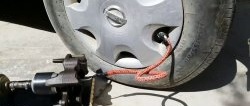
12V compressor from refrigerator compressor
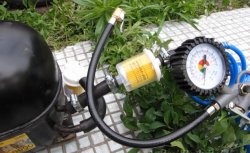
Refrigerator compressor for inflating tires

The simplest do-it-yourself sandblasting nozzle for a compressor
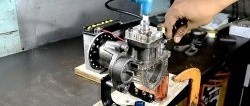
How to make a gasoline engine from a refrigerator compressor
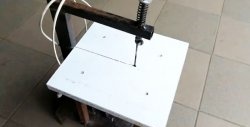
Jigsaw from a compressor from a refrigerator
Particularly interesting
Comments (11)

